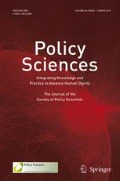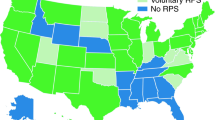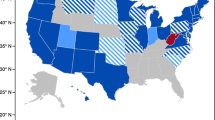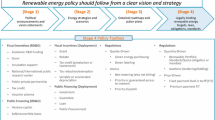Abstract
Renewable portfolio standards (RPS) differ widely across US states. Prior research findings on the effectiveness of these policies to stimulate renewable electricity deployment are equally wide ranging. This study investigates patterns of RPS policy design and analyzes the effects on policy outcomes measured at the level of utility compliance. Measuring organizational outcomes of RPS corrects for the first time the challenges of prior research focused on state-level renewable capacity or generation outcomes. The quantitative analysis also takes into account the complexity of RPS design, by making use of a state-by-state database of RPS design characteristics developed for this study. Patterns of RPS design across states are compared, including the compliance schedule, scope, eligibility of resources, quotas and subsidies, renewable energy credit provisions, as well as enforcement and penalties. Together, the map of state RPS design and the new approach to RPS outcome analysis illuminate the diversity of RPS policy practice across the United States. They suggest the need to both account for the variety of design characteristics and accurately specify the policy outcomes in evaluations of these policies.



Similar content being viewed by others
Notes
Due to the large number of state RPS, a graphic depiction of individual compliance schedules is difficult. A state-by-state listing of RPS schedules (ultimate year and goal) and the average annual percentage point increase is included in the final summary Fig. 3.
This goal only applies to Minnesota’s largest utility, selling two thirds of the state’s electricity.
Although Texas has a capacity goal, compliance is based on renewable energy credits (MWh). Regulators calculate the required credits using a capacity factor.
Arguably, these elements make the standard more flexible, but with regard to the primary policy outcome investigated in this study, their chief impact is on goal stringency.
2007 is the first year in which more than half of all RPS states have a goal.
Ratings were available for ten out of twelve states (not Hawaii and DC).
Shrimali and Kniefel (2011) find an effect of capacity requirements, but not of generation requirements.
References
Apt, J., Lave, L. B., & Pattanariyankool, S. (2008). A national renewable portfolio standard? Not practical. Issues in Science & Technology, 25 (1), 53–59.
Berry, D. (2002). The market for tradable renewable energy credits. Ecological Economics, 42(3), 369.
Berry, D., & Jaccard, M. (2002). The renewable portfolio standard: Design considerations and an implementation survey. Energy Policy, 29, 263–277.
Bird, L., Hurlbut, D., Donohoo, P., Cory, K., & Kreycik, C. (2009). An examination of the regional supply and demand balance for renewable electricity in the United States through 2015. Report NREL/TP-6A2-45041, National Renewable Energy Laboratory, Golden, CO.
Blyth, W., Bradley, R., Bunn, D., Clarke, C., Wilson, T., & Yang, M. (2007) Investment risks under uncertain climate change policy. Energy Policy, 35(11), 5766–5773.
Boehmke, F. J., & Skinner, P. (2012). State policy innovativeness revisited. State Politics & Policy Quarterly (forthcoming).
Bohn, C., & Lant, C. (2009). Welcoming the wind? Determinants of wind power development among US states. The Professional Geographer, 61(1), 87–100.
del Brío, J. A., Fernández, E., & Junquera, B. (2002). The role of the public administrations in the promotion of the environmental activity in Spanish industrial companies. Ecological Economics, 40(2), 279–294.
Brunekreeft, G., & McDaniel, T. (2005). Policy uncertainty and supply adequacy in electric power markets. Oxford Review of Economic Policy, 21(1), 111–127.
Brunner, R. D. (1997). Introduction to the policy sciences. Policy Sciences, 30(4), 191–215. doi:10.1023/A:1004240107843.
Buckman, G. (2011). The effectiveness of renewable portfolio standard banding and carve-outs in supporting high-cost types of renewable electricity. Energy Policy, 39(7), 4105–4114.
Bunker, D. (1972). Policy sciences perspectives on the implementation process. Policy Sciences, 3, 71–80.
Burtraw, D. (1995). Efficiency sans allowance trades? Evaluating the SO2 emission trading program to date. Discussion paper no. 95-30, Resources for the Future, Washington, D.C.
Bushnell, J., & Peterman, C. C. W. (2008). Local solutions to global problems: Climate change policies and regulatory jurisdiction. Review of Environmental Economics and Policy, 2, 174–193.
Caplan, A. J. (2003). Reputation and the control of pollution. Ecological Economics, 47(2/3), 197.
Carley, S. (2009). State renewable energy electricity policies: An empirical evaluation of effectiveness. Energy Policy, 37. 3071–3081.
Carley, S. (2011). The era of state energy policy innovation: A review of policy instruments. Review of Policy Research, 28(3), 265–294.
CESA. (2012). Designing the right RPS. A guide to selecting goals and program options for a renewable portfolio standard. Report, Clean Energy States Alliance. Prepared by Warren Leon for the State-Federal RPS collaborative and the National Association of Utility Commissioners.
Chen, C., Wiser, R., Mills, A., & Bolinger, M. (2009). Weighing the costs and benefits of state renewables portfolio standards in the United States: A comparative analysis of state-level policy impact projections. Renewable & Sustainable Energy Reviews, 13(3), 552–566.
Cooper, C. (2008). A national renewable portfolio standard: Politically correct or just plain correct? Electricity Journal, 21(5), 9–17.
Cory, K., Couture, T., Kreycik, C. (2009). Feed-in tariff policy: Design, implementation, and RPS policy interactions. Report NREL/TP-6A2-45549, Ernest Orlando Lawrence Berkeley National Laboratory, Berkeley, CA.
Cory, K. S., & Swezey, B. G. (2007). Renewable portfolio standards in the states: Balancing goals and rules. Electricity Journal, 20(4), 21–32.
Costello, K. (2005). Regulatory discretion in implementing renewable portfolio standards: The case of Hawaii. Electricity Journal, 18(5), 51–58.
Crandall, K. (2010). Trust and the green consumer: The fight for accountability in renewable energy credits. Colorado Law Review, 81, 895–958.
Davies, L. L. (2012). State renewable portfolio standards: Is there a “race” and is it “to the top”? San Diego Journal of Climate & Energy Law, 3(1), 3–78.
Delmas, M. A. , & Montes-Sancho, M. J. (2011). U.S. state policies for renewable energy: Context and effectiveness. Energy Policy, 39(5):2273–2288. doi:10.1016/j.enpol.2011.01.034.
Dobesova, K., Apt, J., & Lave, L. B. (2005). Are renewables portfolio standards cost-effective emission abatement policy? Environmental Science & Technology, 39(22), 8578–8583.
Doris, E., McLaren, J., Healey, V., & Hockett, S. (2009). State of the states 2009: Renewable energy development and the role of policy. Report NREL/TP-6A2-46667, National Renewable Energy Laboratory, Golden, CO.
EIA. (1998). Electric trade in the United States 1996. Report DOE/EIA-0531(96), Energy Information Administration, U.S. Department of Energy, Washington, D.C.
EIA. (2009). State renewable electricity profiles 2007. Report, Energy Information Administration, U.S. Department of Energy, Washington, D.C.
EIA. (2011). Electric power monthly. Periodical, Energy Information Administration, U.S. Department of Energy, Washington, D.C.
Espey, S. (2001). Renewables portfolio standard: A means for trade with electricity from renewable energy sources? Energy Policy, 29(7), 557–566.
Fischer, C. (2010). Renewable portfolio standards: When do they lower energy prices? Energy Journal, 31(1), 101–119.
Fischlein, M., Smith, T. M., & Wilson, E. J. (2009). Carbon emissions and management scenarios for consumer-owned utilities. Environmental Science & Policy, 12, 778–790.
Fischlein, M., Larson, J., Hall, D., Chaudhry, R., Stephens, J. C., Wilson, E. J.,et al. (2010). Policy stakeholders and deployment of wind power in the sub-national context: A comparison of four U.S. states. Energy Policy, 38(8), 4429–4439.
Fremeth, A. J. (2009). The dynamic relationship between firm capabilities, regulatory policy, and environmental performance: Renewable energy policy and investment in the U.S. electric utility sector. PhD thesis, University of Minnesota.
Friedlander, S. C., & Sawyer, S. W. (1983). Innovation traditions, energy conditions, and state energy policy adoption. Policy Sciences, 15, 307–324.
Fuss, S., Johansson, D. J. A., Szolgayova, J., & Obersteiner, M. (2009). Impact of climate policy uncertainty on the adoption of electricity generating technologies. Energy Policy, 37(2), 733–743.
Gaul, C., & Carley, S. (2012). Solar set asides and renewable energy certificates: Early lessons from North Carolina’s experience with its renewable portfolio standard. Energy Policy, 48, 460–469.
Gillenwater, M. (2008a). Redefining RECs—part 1: Untangling attributes and offsets. Energy Policy, 36(6), 2109–2119.
Gillenwater, M. (2008b). Redefining RECs—part 2: Untangling certificates and emission markets. Energy Policy, 36(6), 2120–2129.
Gold, I., & Thakar, N. (2010). A survey of state renewable portfolio standards: Square pegs for round climate change holes? William & Mary Environmental Law and Policy Review, 35, 183–268.
Golden, K. S. (2003). Senate bill 1078: The renewable portfolio standard—California asserts its renewable energy leadership. Ecology Law Quarterly, 30(3), 693–713.
Gray, W., & Scholz, J. (1993). Does regulatory enforcement work—A panel analysis of OSHA enforcement. Law & Society Review, 27, 177.
Hilton, S. (2006). The impact of California’s global warming legislation on the electric utility industry. Electricity Journal, 19(9), 10–16.
Hoffman, A. (2001). From heresy to dogma: An institutional history of corporate environmentalism. Stanford, CA: Stanford Business Books.
Holt, E., Wiser, R., & Bolinger, M. (2006). Who owns renewable energy certificates? An exploration of policy options and practice. Report LBNL-59965, Lawrence Berkeley National Laboratory, Berkeley, CA.
Holt, E. A., & Wiser, R. H. (2007). The treatment of renewable energy certificates, emissions allowances, and green power programs in state renewables portfolio standards. Report, Ernest Orlando Lawrence Berkeley National Laboratory, Berkeley, CA.
Hopper, N., Barbose, G., Goldman, C., & Schlegel, J. (2008). Energy efficiency as a preferred resource: Evidence from utility resource plans in the western united states and canada. Report LBNL-1023E, Ernest Orlando Lawrence Berkeley National Laboratory, Berkeley, CA.
Horiuchi, C. (2007). One policy makes no difference? Administrative Theory & Praxis, 29(3), 432–449.
Huang, M. Y., Alavalapati, J. R., Carter, D. R., Langholtz, M. H. (2007). Is the choice of renewable portfolio standards random? Energy Policy, 35, 5571–5575
Huitema, D., Jordan, A., Massey, E., Rayner, T., van Asselt, H., Haug, et al. (2011). The evaluation of climate policy: Theory and emerging practice in europe. Policy Sciences, 44, 179–198
Hurlbut, D. (2008). A look behind the Texas renewable portfolio standard: A case study. Natural Resources Journal, 48(1), 129–161.
Jaffe, A., Palmer, K. (1997). Environmental regulation and innovation: A panel data study. Review of Economics and Statistics, 79(4), 610–619.
Jiusto, S. (2006). The differences that methods make: Cross-border power flows and accounting for carbon emissions from electricity use. Energy Policy, 34(17), 2915–2928.
Karpoff, J. M., Lott, J. R., & Wherly, E. W. (2005). The reputational penalties for environmental violations: Empirical evidence. Journal of Law and Economics, 48(2), 653–675.
Keeler, A. G. (2007). State greenhouse gas reduction polices: A move in the right direction. Policy Sciences, 40:353–365.
Koski, C. (2007). Examining state environmental regulatory policy design. Journal of Environmental Planning & Management, 50(4), 483–502.
Kosloff, L. H., Trexler, M. C., & Nelson, H. (2004). Outcome oriented leadership: How state and local climate change strategies can most effectively contribute to global warming mitigation. Widener Law Journal, 14(1), 173–204.
Krozer, Y., & Nentjes, A. (2008). Environmental policy and innovations. Business Strategy and the Environment, 17(4), 219–229.
Kutner, M. H., Nachtsheim, C. J., Neter, J., & Li, W. (2005). Advanced linear statistical models (5th edn). New York: McGraw-Hill International.
Lafrancois, B. (2009). Investment in intermittent renewables: Modeling optimal compliance under a renewable portfolio standard with varying penalty structures. Presented at 1000 islands energy research forum, October 23–25. Alexandria Bay, NY.
Langniss, O., & Wiser, R. (2003). The renewables portfolio standard in Texas: An early assessment. Energy Policy, 31(6), 527–535.
Lanjouw, J. O., & Mody, A. (1996). Innovation and the international diffusion of environmentally responsive technology. Research Policy, 25, 549–571.
Lokey, E. (2007). Valuing renewable energy in emerging U.S. carbon markets. The Electricity Journal, 20(6), 46–57.
Majumdar, S. K., Marcus, A. A. (2001). Rules versus discretion: The productivity consequences of flexible regulation. Academy of Management Journal, 44(1), 170–179.
Managi, S., Opaluch, J. J., Di, J., & Grigalunas, T. A. (2005). Environmental regulations and technological change in the offshore oil and gas industry. Land Economics, 81(2), 303–319.
Marcus, A. (1981). Policy uncertainty and technological innovation. Academy of Management Review, 6(3), 443–448.
Matisoff, D. C. (2008). The adoption of state climate change policies and renewable portfolio standards: Regional diffusion or internal determinants? Review of Policy Research, 25(6), 527–546.
Meijer, I., Hekkert, M., & Koppenjan, J. (2007). The influence of perceived uncertainty on entrepreneurial action in emerging renewable energy technology: Biomass gasification projects in the Netherlands. Energy Policy, 35(11), 5836–5854.
Menz, F. C. (2005). Green electricity policies in the United States: Case study. Energy Policy, 33(18), 2398–2410.
Menz, F. C., & Vachon, S. (2006). The effectiveness of different policy regimes for promoting wind power: Experiences from the states. Energy Policy, 34(14), 1786–1796.
Michaels, R. J. (2008). A national renewable portfolio standard: Politically correct, economically suspect. Electricity Journal, 21(3), 9–28
Milliman, S. R., & Prince, R. (1989). Firm incentives to promote technological change in pollution control. Journal of Environmental Economics and Management, 17(3), 247–265.
Millock, K., & Sterner, T. (2004). No x emissions in France and Sweden. Advanced fee schemes versus regulation. In: W. Harrington, R. D. Morgenstern, & T. Sterner (Eds.) Choosing environmental policy. Comparing instruments and outcomes in the United States and Europe, Resources for the Future, Washington, D.C., pp. 117–132.
Nehrt, C. (1998). Maintainability of first mover advantages when environmental regulations differ between countries. Academy of Management Review, 23, 77–97.
North Carolina Solar Center. (2009). Database of state incentives for renewable energy. Raleigh, NC. http://www.dsireusa.org/.
Osborne, J. (2002). Notes on the use of data transformations. Practical Assessment, Research & Evaluation, 8(6). (online edition).
Palmer, K., & Burtraw, D. (2005). Cost-effectiveness of renewable electricity policies. Energy Economics, 27(6), 873–894. doi:10.1016/j.eneco.2005.09.007.
Porter, M. E., & van der Linde, C. (1995). Toward a new conception of the environment competitiveness relationship. Journal of Economic Perspectives, 9(4), 97–118.
Rabe, B. G. (2004). North American federalism and climate change policy: American state and Canadian provincial policy development. Widener Law Journal, 14(1), 121–172.
Ratliff, N., & Smith, D. H. (2005). Renewable energy electricity state level policies in the WRAP region: What, why and maybe how. Energy Sources, 27(5), 431–444.
Rechtschaffen, C. (1998). Deterrence vs. cooperation and the evolving theory of environmental enforcement. California Law Review, 71(6), 1181–1273.
Richards, K. R. (2000). Framing environmental policy instrument choice. Duke Environmental Law and Policy Forum, 10(20), 221.
Rico, R. (1995). The U.S. allowance trading system for sulfur dioxide: An update on market experience. Energy and Resource Economics, 5(2), 115–29.
Ringquist, E. J. (1993). Does regulation matter? Evaluating the effects of state air pollution control programs. The Journal of Politics, 55(4), 1022–1045.
Roediger-Schluga, T. (2002). The stringency of environmental regulation and the “Porter Hypothesis”. Economy and Environment, 25, 123–148.
Shrimali, G., & Kniefel, J. (2011). Are government policies effective in promoting deployment of renewable electricity resources? Energy Policy, 39(9), 4726–4741. doi:10.1016/j.enpol.2011.06.055.
Shrivastava, P. (1995). Environmental technologies and competitive advantage. Strategic Management Journal, 16, 183–200.
Stafford, S. L. (2002). The effect of punishment on firm compliance with hazardous waste regulations. Journal of Environmental Economics and Management, 44(2), 290–308.
Stockmayer, G., Finch, V., Komor, P., & Mignogna, R. (2011). Limiting the costs of renewable portfolio standards: A review and critique of current methods. Energy Policy, 42, 155–163. doi:10.1016/j.enpol.2011.11.060.
Tarui, N., & Polasky, S. (2005). Environmental regulation with technology adoption, learning and strategic behavior. Journal of Environmental Economics and Management, 50(3), 447–467.
Taylor, M., Rubin, E., & Hounshell, D. (2005). Regulation as the mother of innovation: The case of SO2 control. Law & Policy, 27(2), 348–378.
Welch, E. W., Mazur, A., & Bretschneider, S. (2000). Voluntary behavior by electric utilities: Levels of adoption and contribution of the climate challenge program to the reduction of carbon dioxide. Journal of Policy Analysis and Management, 19(3), 407–425
Wheater, C. P., & Cook, P. A. (2000). Using statistics to understand the environment. London, New York: Routledge
Wheeler, S. M. (2008). State and municipal climate change plans: The first generation. Journal of the American Planning Association, 74(4), 481–496.
Wiser, R., & Barbose, G. (2008). Renewables portfolio standards in the United States—A status report with data through 2007. Report LBNL-154E, Lawrence Berkeley National Laboratory, Berkeley, CA.
Wiser, R., Porter, K., Bolinger, M., Raitt, H. (2005). Does it have to be this hard? Implementing the nation’s most complex renewables portfolio standard. Electricity Journal, 18(8), 55–67.
Wiser, R., Namovicz, C., Gielecki, M., & Smith, R. (2007). The experience with renewable portfolio standards in the United States. The Electricity Journal, 20(4), 8–20.
Wiser, R., Barbose, G., & Holt, E. (2011). Supporting solar power in renewables portfolio standards: Experience from the United States. Energy Policy, 39(7), 3894–3905.
Wong Kup, J., Gittleman, R. M., Hall, C. W., & Vanko, M. N. (2009). California’s renewables portfolio standard: Charting the course towards 33 % by 2020. Electricity Journal, 22(4), 79–94.
Yang, M., Blyth, W., Bradley, R., Bunn, D., Clarke, C., & Wilson, T. (2008). Evaluating the power investment options with uncertainty in climate policy. Energy Economics, 30(4), 1933–1950.
Yin, H., & Powers, N. (2010). Do state renewable portfolio standards promote in-state renewable generation? Energy Policy, 38(2), 1140–1149.
Author information
Authors and Affiliations
Corresponding author
Rights and permissions
About this article
Cite this article
Fischlein, M., Smith, T.M. Revisiting renewable portfolio standard effectiveness: policy design and outcome specification matter. Policy Sci 46, 277–310 (2013). https://doi.org/10.1007/s11077-013-9175-0
Published:
Issue Date:
DOI: https://doi.org/10.1007/s11077-013-9175-0




